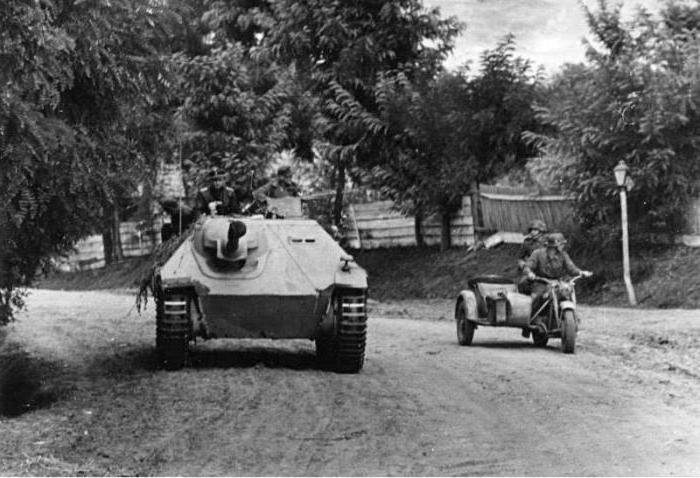SS Division Florian Geyer was formed in the middle of World War II. The unit played a significant role in the events on the Eastern Front of Nazi Germany. In the hands of the soldiers of the division is the blood of thousands of Soviet soldiers and civilians. The Nazis distinguished themselves with particular cruelty in the territory of the Byelorussian SSR, where whole villages were burned.
However, in 1945, a well-deserved retribution still overtook this unit.
Name history
Florian Geyer, who was named after the 8th Cavalry Division of the SS, was a real person who lived in the sixteenth century in southern Germany. At that time, the Holy Roman Empire established new requisitions for the peasant population, which caused discontent among the masses. After some time, a riot began, which grew into an uprising. Florian was a noble family, but nonetheless sincerely empathized with the poor. Therefore, he immediately joined the rebels with the personal money received from the sale of property, armed several dozen people. Florian Geyer's "Black Squad" formed the basis of the new army. The mastermind himself proved himself to be an outstanding negotiator. He was part of every group of parliamentarians whom the rebels sent to the princes of the besieged cities. Thanks to diplomatic skills, Florian Geyer succeeded in surrendering without a fight.
Despite initial success, the peasant uprising was defeated, and Geyer himself was killed. But for the German people, he became a semi-legendary person (like Robin Hood in the UK). Many songs, fairy tales and other elements of folklore are devoted to him. In the forty-second year, the situation inside Nazi Germany was heating up. Every day the scale of mobilization increased. The SS elite troops were already drafted without the previous demanding inspection and rigorous selection. To prove the nationality of the army (and, accordingly, the same character of the ongoing war), the Florian Geyer division was created.
Baptism of fire
The Eighth Cavalry Division of the SS was created on the basis of the Dead Head group. Initially, the fighters of these units were intended to protect concentration camps and to combat elements unwanted by the Fuhrer within German society. However, with the outbreak of war against the Soviet Union, the Waffen SS began to be used on the front. The personnel was fanatically devoted to the ideas of National Socialism and carried out any orders of the command. The Florian Geyer division first showed itself in battles near Rzhev. At this time, the Germans held a stubborn defense there.
The front was commanded by one of Hitler's most talented commanders - Walter Model.
The Red Army conducted offensive operations four times, trying to surround the German group, but to no avail. The Eighth Division was commanded by Fritz Freytag.
Anti-partisan war
In the spring of the forty-third, local partisans intensified in the forests of Belarus. They regularly made sorties, destroying personnel, armored vehicles, enemy fodder. Despite all the measures taken, the Nazis could not suppress the resistance. Therefore, in May, Commander Erich Bach-Zeleuski decided to conduct a large-scale operation with the goal of breaking up partisan formations in Polesie and Volhynia. The Florian Geyer division was directly involved in these promotions. During the operation, many crimes against humanity were committed. The Nazis burned entire villages, killing all the inhabitants indiscriminately. The partisans put up desperate resistance in the forests and swamps, suffering heavy losses. The eighth division of the SS was particularly cruel, for which Bakh-Zelevsky decided to transfer the unit to personal control.

At this time, Soviet troops advanced in the Kharkov region, where they sent the division. Using their bloody fame, the SS continued the anti-guerrilla war. At a critical moment, the Wehrmacht command sent a division soldier to the front line to deter a tank breakthrough. After the liberation of Kharkov by the Red Army, the Florian Geyer together with other German troops retreated to Kremenchug.
Anti-polish stocks
In the forty-fourth, fighting came to Poland. This was a signal to intensify Polish resistance. The partisans of the Home Army began to actively engage in clashes with the invaders, often coordinating their actions with the advancing Soviet troops. To eliminate this threat, Erich Bach ordered the eighth SS division to carry out an anti-guerrilla raid. During the operation, the Nazis acted with the same cruelty as in the forests of Belarus. But in the spring near Kovel the seventeenth regiment of the division was surrounded.
The rebels almost completely destroyed him. Some survivors were saved only by the arrival of reinforcements.
End of the battle path
After leaving Poland, Florian Geyer fought in Hungary. There they suffered heavy losses. Some regiments continued to engage in anti-partisan actions on various fronts. For example, against the Yugoslav rebels in the forty-fourth. The eighth SS cavalry division was defeated in Budapest. In the winter of forty-fifth, Soviet troops took the city in a ring. Despite all the attempts of the German command, the besieged could not provide serious resistance. As a result, in mid-February, they managed to escape from the encirclement, but the Red Army staged a successful pursuit, as a result of which almost all the personnel were destroyed.
Commander Joachim Rumor was also killed. Separate surviving soldiers were able to leave for their troops, and they were sent to form a new thirty-third SS cavalry division.
The memory of the division
Florian Geyer rebels play an important role in German history. Under any regime, they were seen as goodies. That is why the Nazi leadership tried to identify with them. However, after the war ended, the new German authorities managed to differentiate the SS criminals from the sixteenth-century rebels. The march "Florian Geyer" is nevertheless still associated in popular culture with Nazi Germany.